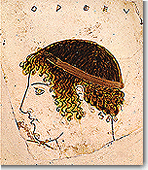





     |
|
|
|
 |
In one version of the myth Maenads dismembered Orpheus and hurled his head and lyre into the Hebrus. The waves threw it up at Antissa in Lesbos, and there, in a cave of Dionysus, the head went on singing and giving oracles. From that time on, talking heads and divination were connected with the Orphic mysteries. The teachings of Orphism, which emerged from the contact of the Thraco-Phrygian cult of Dionysus with Hellenic religious elements, had a cosmological and eschatological content. The initiates were called Orphotelestai, and practised prophecy and healing. In Classical times, to judge by Plato's views, they enjoyed no particular esteem. Again, the Sibyl, originally thought of as a female prophet from Marpessus on the Hellespont or from Erythrae in Ionia, prophesied in the Oriental fashion, that is to say, she went from town to town and from country to country. According to Pausanias, she also went to Delphi, where she was called Herophile. Her prophecies were carried to Cyme in Campania and to Rome. In time the impression was formed that this was a female priest who had lived many years before, and various collections with her prophecies were compiled, to survive even after the end of the ancient world. |
But the seedbed par excellence of prophets and healers was the Peloponnesus and Boeotia. Melampus was from the Argive prophet family of the Amythaonidae: he once saved his life by having made himself 'indispensable' to his captors through his healing gifts. In the Hesiodic poem Melampodia there was information about a prophet who married the Hellenic with the Oriental tradition. This was Mopsus grandson of Tiresias. Mopsus, thought to be the Mopsus who defeated Calchas in a contest, travelled in Asia Minor; founded the oracle of Klaros; and reached Cilicia. He was regarded as the founder of the city of Mopsuestia; is mentioned in a Hittite inscription of the 8th century B.C.; and was connected with the lineage of the
|
| |
|
Note: Click on a picture for a brief description. | |